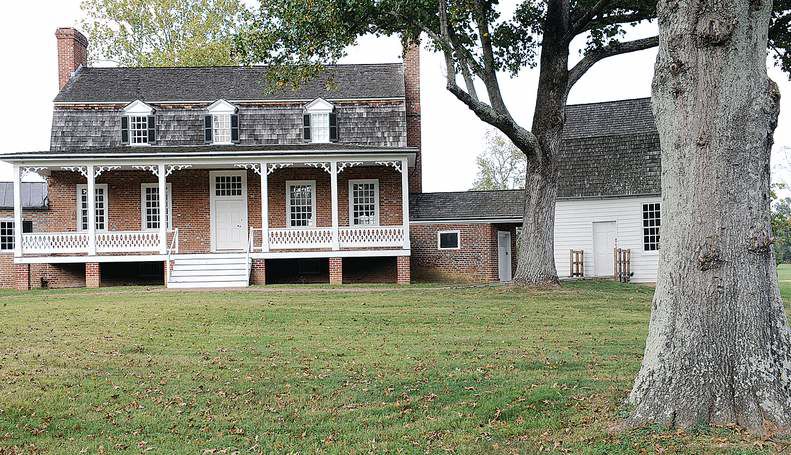Humble park typifies shift from scenic to cerebral
Published 5:00 am Sunday, September 27, 2009

- In the 1970s, Congress approved paying $525,000 to buy Thomas Stone's old home and estate near Port Tobacco, Md., despite the facts that the house had recently burned, and the Park Service didn't even want it before the fire.
PORT TOBACCO, Md. — Welcome to America’s 344th-best idea.
It sits in the woods of Charles County, Md., a monument to a man who — besides signing the Declaration of Independence — arguably didn’t do much to deserve one.
In a time of revolution, he was a moderate. In an era of national heroes, he played a modest part as a Maryland state senator. Then he died, and his house was gutted by a fire.
Somehow, though, Thomas Stone still got a national park. But not a very popular one.
The Thomas Stone National Historic Site ranked 344th last year among 360 sites where the National Park Service tracks attendance.
As public broadcasting stations begin to air filmmaker Ken Burns’ new miniseries, “The National Parks: America’s Best Idea,” rangers at the lonely visitors center here make the case that the Thomas Stone site is not a mistake but actually an example of the park system’s next big idea.
If anybody believes it, there will be lots of available parking.
“We’re here,” said Scott Hill, the site’s supervisory park ranger. “And (we) want to see people.”
In his six-part series, Burns focuses heavily on “The Big 58,” the scenery-rich icons such as Yosemite, Yellowstone, the Grand Canyon and Hawaii Volcanoes that carry the formal title “National Park.”
The point of Burns’ narrative is that the concept of a protected slice of nature — open not only to the wealthy or to royalty but to everybody — was an American invention.
The parks were “an idea … as uniquely American as the Declaration of Independence, and just as radical,” the film’s narrator says.
In 12 hours of film, the Thomas Stone National Historic Site isn’t mentioned once.
“We made a conscious decision and said: ‘This is no encyclopedia. This is no telephone book,’” Burns said in a telephone interview Friday.
A Declaration signer — but little else
The park’s eponym, Thomas Stone, was a farmer, lawyer and delegate from Maryland to the Continental Congress in 1776. There, in Philadelphia, that Congress produced some of the most eloquent words and boldest deeds in American history.
But very few of them were said or done by Thomas Stone. He was said to be a poor speaker, and he was on the losing side of the debate, arguing that the colonies should reconcile with Britain instead of breaking away.
Still, when the Congress finally voted for independence, he went along — signing “Thos. Stone” three spots below John Hancock. As with the other 55 signers, he was committing treason against Britain, risking arrest or death if the rebellion failed.
Afterward, Stone returned to his estate, “Haberdeventure” (the name means something like “a dwelling place in the winds,” park officials say), near Port Tobacco. He served in the state Senate and died at 44 in 1787.
Then, about 190 years later, Stone’s name came up in Congress again. Legislators approved paying $525,000 to buy his old home and estate, even though the home had recently burned, and the Park Service didn’t want it before the fire. An official said in 1978 that it was “of marginal value and (doesn’t) meet the standards for inclusion in the National Park Service,” according to The Associated Press.
The reason, critics said: Congressional leaders needed a vote from then-Rep. Bob Bauman, R-Md., who represented the area and saw the site as a pet project. Bauman, who was defeated in 1980, did not respond to a request for comment.
Beyond ‘rocks and ice’
Last year, the site got 5,720 visitors. That was fewer people than visited two Alaskan parks that can’t be reached by road.
On some days, the site’s small, brightly lit visitor center is crowded with school field trips. But on others, the rangers might see five or six people.
“I’m always like, ‘Yay!’” when the front door chime rings, said Whitney Crouch, 22, a ranger who transferred here from a park in Alaska where cruise ships could dump in 10,000 people a day. “I’m like, ‘I hope it’s not UPS again.’ “
So do we really need Thomas Stone National Historic Site, which costs the federal government $638,000 a year?
Park Service officials say it fits with a strategy to expand the U.S. park system beyond the kind of places that Burns’ film focuses on — the “rocks and ice,” parks people say.
The new places include Little Rock Central High School National Historic Site, the setting for a desegregation battle, and Manzanar National Historic Site, where Japanese-Americans were interned during World War II. Places where the park experience shifts from stand-there-and-gape to stand-there-and-imagine.
Historical and cultural parks such as this make up about half of the park system’s 391 sites. A report sponsored by the National Parks Conservation Association this week called them “an idea expressed in terms of place.”
The Thomas Stone site is one of only four national parks with homes of signers of the Declaration. So here, park rangers say, visitors can imagine what it felt like to choose a new kind of government and defy one of the most powerful countries on Earth.
Here it might actually help that Thomas Stone was a bit of a nobody.
“He’s everyman,” Hill said. “He’s not George Washington. He’s not the central figure. He’s Thomas Stone. … He’s what you or I could have been.”






